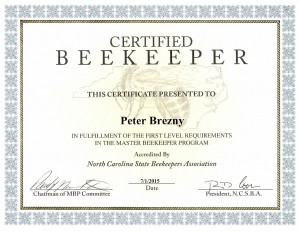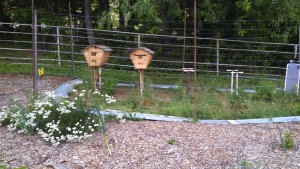Early this summer, I passed the written and practical tests in the first step toward becoming a master beekeeper. There’s plenty of information in books and on the web for anyone to pick up caring for bees without going to the extra work of becoming certified. I found that having the goal of certification and the eventual multi year path toward becoming a master bee keeper spurred me on to keep studying and learning new things about bees.

Becoming a “Bee Guardian” as the folks at backyardhive.com like to call themselves isn’t without its challenges. Not the least of which is the initial expense (either in time or money) of building or buying hives and purchasing or capturing a colony of bees. And if you want to be a bee guardian, you do have to accept the fact that, when opening a box with sometimes more than 50,000 insects inside, you are going to get stung at some point. It can be a little intimidating at first, even with protective clothing, to get used to the colonies normal activity, and figure out how best to interact with them when attempting to assist them in surviving this chemical and GMO filled world we have now. Here’s a short video of our hives in action from the April 2015 photo album on google plus.
Just setting up the apiary or bee yard was a bit more work than I anticipated, and keeping the bees safe from Bears does require power, a well constructed fence and powerful electric fence energizer. And although after two years of learning the ropes and not collecting a single jar of honey, it’s been well worth the effort. Knowing we have hundreds of thousands of hungry little mouths to feed at the farm at any one time has really changed the way we think about weeds–at least those with flowers on them and we’re tilling up all kinds of formerly grassy areas to plant with wildflowers. We mow a lot less, which is fantastic in all kinds of ways, tolerate a lot more flowering ‘weeds’, and have been rewarded with a better understanding of these insects, and their wild pollinator cousins life cycles and importance to the natural world.
A few technical details about the apiary. We’ve had great luck with the Gallagher b80 (0.8 joule) energizer, a 100 w solar panel, and a marine deep cycle battery. The fence itself may be a little overkill, eight feet tall with a wire every six inches, and a separate ground wire right at ‘bear nose height’ to make sure even in really dry weather, that anything attempting to get past the fence is going to get a good kick. To save money and not use plastic insulators that will ultimately just wind up in the landfill, we cut diagonal notches in thin, wood strips, then used a drill to square off a hole for the wire to pass through, making it easy to push stiff wire into the strips. A few images can be found in the google plus gallery from June 2014, or see this image.
The welded ‘T’ pipes driven into the ground as hive supports have been great, putting the hives up high enough off the ground to keep skunks from picking off the bees as they come and go, and making it easy to walk around in the yard between the hives without having to step over cinder blocks or trellis boards.




